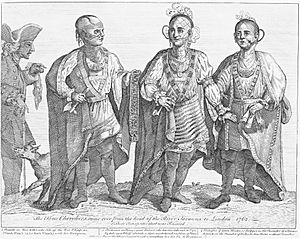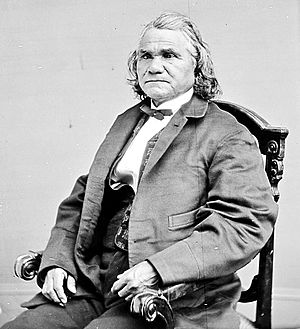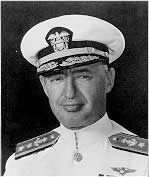Cherokee military history facts for kids
The Cherokee people, who originally lived in the southeastern United States and later in Oklahoma, have a long and brave military history. Europeans first wrote about Cherokee military actions many years ago. During the 1700s, different Cherokee groups often had conflicts with European settlers, especially the British colonists from the Southern Colonies.
Later, during the American Civil War, some Cherokee groups fought for the Union (the North), while others joined the Confederacy (the South). Because many Cherokees sided with the Confederacy, the United States government made a new agreement with them after the war. Cherokees have also served in the United States military in the 1900s and 2000s.
Contents
- Traditional Military Leaders
- Cherokee and Chickasaw vs. Shawnee (1710)
- Tuscarora War
- Yamasee War
- War with the Muscogee-Creeks
- Anglo-Cherokee War (1759–61)
- War with the Chickasaw and Land Cessions (1763)
- Watauga Association
- Transylvania Purchase
- Second Cherokee War
- Cherokee–American Wars
- After the Wars
- Alliance with USA against Muscogee/Creek (1814)
- American Civil War
- 20th Century
- 21st Century
Traditional Military Leaders
Before the 1700s, Cherokee leaders were split into two types: "white" chiefs for peace and "red" chiefs for war. When there was a conflict, the red chief would gather young men for war parties. He had help from a deputy, a speaker, and messengers. Decisions were made by a war council with members from the seven Cherokee clans. Women, including the important "beloved woman" (Ghigau), could join the council or go with war parties. Scouts and medicine men also helped the war parties.
Cherokee and Chickasaw vs. Shawnee (1710)
Around 1710, the Cherokee and the Chickasaw people pushed their enemies, the Shawnee, north of the Ohio River. Years before, the Cherokee had let some Shawnee settle in the Cumberland Basin when they were running from the Iroquois. The Shawnee also acted as a protective barrier against the Chickasaw, who were traditional enemies of the Cherokee.
The Cherokee allowed another Shawnee group to pass through their land to settle near the Savannah River. This group would help protect them from the Catawba. More Shawnee, who were allied with the French, came into the area. This caught the attention of the Iroquois. The Cherokee and Chickasaw, who were allied with the British, decided to work together to remove the Shawnee from their lands. This conflict lasted from 1710 to 1715. Small fights continued for over 50 years. Finally, in 1768, the Shawnee and Cherokee made a peace treaty.
Tuscarora War
The Cherokee were not much affected by European settlers until the Tuscarora War. In 1711, the Tuscarora started attacking settlers in North Carolina. This happened after their attempts to solve problems peacefully failed. The governor of North Carolina asked South Carolina for military help. Before the war ended, South Carolina sent two armies against the Tuscarora. These armies were mostly made up of Native American warriors, especially Yamasee troops.
The first army, led by John Barnwell, fought in North Carolina in 1712. No Cherokee were part of this army. After a short peace, fighting started again.
In late 1712 and early 1713, a second army from South Carolina fought the Tuscarora. This army, led by Colonel James Moore, included many Native American warriors, with hundreds of Cherokee joining. The war ended after the Tuscarora were defeated at Hancock's Fort. Over 1,000 Tuscarora and their allies were killed or captured. Many prisoners were sold. The Tuscarora War changed things in colonial America. It made the Iroquois more interested in the South. For the many Native Americans involved, it was the first time so many had fought together. It also showed them how different the English colonies were. The war helped connect the region's Native Americans and improved their communication and trade. The Cherokee became more involved with other Native Americans and Europeans. This war started a strong relationship between the English and Cherokee that lasted for much of the 1700s.
Destruction of Chestowee
The Tuscarora War also showed the growing military strength of the Cherokee. This was clear in 1714 when they attacked and destroyed the Yuchi town of Chestowee. English traders encouraged this attack with lies, though there was already a conflict between the Cherokee and Yuchi. The attack was planned in the Cherokee town of Euphase and involved mostly local Cherokees.
In May 1714, the Cherokee destroyed Chestowee. Survivors who were not captured fled to the Creek or other Yuchi groups. The traders falsely told the Cherokee that South Carolina supported the attack. When the South Carolina governor heard about this, he sent a message telling the Cherokee to stop. But the message arrived too late to save Chestowee. The Cherokee attack on the Yuchi ended with Chestowee. However, it got the attention of every tribe and European colony in the region. Around 1715, the Cherokee became a major power in the area.
Yamasee War
In 1715, as the Tuscarora War was ending, the Yamasee War began. Many tribes attacked South Carolina. The Cherokee joined some attacks but were divided on what to do. After South Carolina's army pushed back the Yamasee and Catawba, the Cherokee became very important. South Carolina and the Lower Creek tried to get Cherokee support. Some Cherokee wanted to ally with South Carolina and fight the Creek. Others wanted the opposite.
The situation changed in January 1716. A group of Creek leaders was killed at the Cherokee town of Tugaloo. After this, the Cherokee attacked the Creek. Peace agreements between South Carolina and the Creek were made in 1717. This made the Cherokee less committed to the war. Fighting between the Cherokee and Creek continued for decades. It ended with the Battle of Taliwa in 1755, where the Creek were defeated. The Creek had already moved most of their settlements from what is now North Georgia to create a buffer zone between themselves and the Cherokee.
In 1721, the Cherokee gave their first land to the British. They sold a small strip of land to the South Carolina colony. Moytoy of Tellico was chosen as "Emperor" by the elders of the main Cherokee towns in 1730. This was requested by Alexander Cumming, who wanted to control the Cherokee. Moytoy agreed to recognize King George II of Great Britain as a protector of the Cherokee. Seven important Cherokee, including Attakullakulla, traveled with Cumming to England. They spent four months in London. Their visit led to the 1730 Treaty of Whitehall, an alliance between the British and the Cherokee. This trip and treaty were important for future British-Cherokee relations. However, the title of Cherokee Emperor had little real power within the tribe.
The Cherokee "empire" was mostly a ceremony. Political power stayed with individual towns for many years. In 1735, the Cherokee were thought to have 64 towns and villages and 6,000 fighting men. In 1738-39, smallpox was brought to the country by sailors and slaves. An epidemic broke out among the Cherokee, who had no natural protection. Nearly half their population died within a year.
War with the Muscogee-Creeks
The Cherokee and Muscogee fought over hunting grounds in what is now North Georgia. This conflict lasted from 1753 to 1755. The Cherokee won after the Battle of Taliwa.
Anglo-Cherokee War (1759–61)
The British heard that the French were planning to build forts in Cherokee territory. So, the British built their own forts: Fort Prince George and Fort Loudoun in 1756. That year, the Cherokee helped the British in the French and Indian War. But serious misunderstandings quickly grew between them. In 1760, the Cherokee surrounded both British forts. They forced a relief army to retreat at the Battle of Echoee and eventually captured Fort Loudoun. The British fought back by sending armies that destroyed 15 Cherokee settlements in 1761. A peace treaty was signed by the end of that year. King George III's Royal Proclamation of 1763 tried to protect the Cherokee. It stopped British settlement west of the Appalachian mountains. But it was hard to enforce.
The Cherokee and Chickasaw continued to fight sometimes with the Shawnee along the Cumberland River. The Shawnee were allied with the Lenape, who remained at war with the Cherokee until 1768.
War with the Chickasaw and Land Cessions (1763)
After their success against the Muscogee, the Cherokee looked west. They fought the Chickasaw over hunting grounds in what is now northeast Alabama from 1758 to 1769. After eleven years of occasional fighting, the Cherokee were defeated at the Battle of Chickasaw Old Fields.
Watauga Association
After the 1771 Battle of Alamance, many North Carolinians refused to promise loyalty to the British King. They left the colony. One man, James Robertson, led a group of families westward. They thought they were in Virginia. They settled on the banks of the Watauga River in what is now northeastern Tennessee. A survey showed they were wrong, and they were told to leave. Cherokee leaders in the area stepped in to help them. They were allowed to stay if they did not take more land. In 1772, Robertson and the settlers met to create a local government called the Watauga Association.
Transylvania Purchase
Daniel Boone and his group tried to settle in the Cherokee's Kentucky hunting grounds. In response, the Shawnee, Lenape, Mingo, and some Cherokees attacked Boone's son and his party. This started Lord Dunmore's War (1773–1774).
In 1775, a group of North Carolina land buyers, led by Richard Henderson, made the Treaty of Watauga. They met with Overhill Cherokee leaders, including Oconostota and Attakullakulla. In this treaty, the Cherokee gave their Kentucky lands to the Transylvania Land Company. The treaty ignored the claims of other tribes like the Shawnee and Chickasaw. Local settlers formed the Washington District and allied with North Carolina for protection.
Dragging Canoe, a Cherokee chief and son of Attakullakulla, refused to accept the deal. He warned, "You have bought a fair land, but there is a cloud hanging over it; you will find its settlement dark and bloody." The governors of Virginia and North Carolina rejected the Watauga treaty.
Second Cherokee War
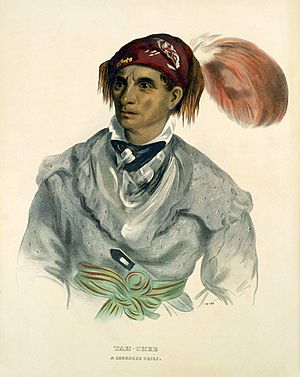
In 1776, the Shawnee chief Cornstalk visited the southern tribes. He met with Cherokee leaders at Chota. He called for all tribes to unite against the American settlers. Dragging Canoe and Abraham of Chilhowee accepted his war belt.
The Cherokee planned attacks on South Carolina, Georgia, Virginia, and North Carolina. The attack by the Overhill Cherokee failed. This was especially true for Dragging Canoe's group against the Holston settlements. The settlers had been warned by the Beloved Woman Nancy Ward. Abraham of Chilhowee could not take Fort Watauga.
North Carolina sent 2,400 troops to destroy the Middle Towns. South Carolina and Georgia sent 2,000 men to attack the Lower Towns. More than fifty towns were destroyed. Houses and food were burned, orchards ruined, and livestock killed. Hundreds of Cherokees were killed, and survivors were captured and sold. Virginia sent a large force, and North Carolina sent volunteers to the Overhill Towns. Dragging Canoe ordered the Cherokee towns burned. He moved women, children, and the elderly south of the Hiwassee River. He planned to ambush the Virginians. Oconostota and other older chiefs wanted peace at any cost.
Dragging Canoe and his followers moved southwest. People from the Lower Towns moved into North Georgia. The Virginia force found many towns empty, with only older chiefs remaining. In 1777, the Cherokee signed treaties agreeing to stop fighting and giving up the Lower Towns. In return, they would be protected from attacks.
Cherokee–American Wars
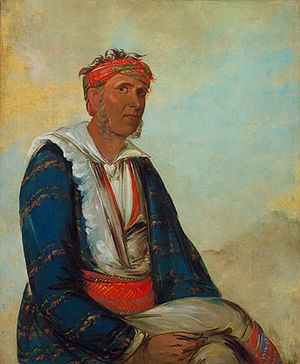
Dragging Canoe and his group moved near what is now Chattanooga, Tennessee. They built eleven new towns. He made his main camp in Chickamauga. Settlers called his group the Chickamauga Cherokee. Dragging Canoe started a guerrilla war that lasted almost twenty years. It caused fear on the western frontier.
Because of the Chickamauga Cherokee, settlers and states launched attacks against the Cherokee. Large forces invaded the Chickamauga area in 1777 and destroyed all eleven towns. After another invasion in 1782, Dragging Canoe and his people moved further west. They became known as the Lower Cherokee. Their main camp was not invaded again until the final year of the wars.
Around this time, Dragging Canoe started working with the Upper Muscogee. They sometimes combined forces for big operations. The Shawnee and other northern tribes were allies. The Shawnee sent warriors to fight with Dragging Canoe's group. Tecumseh, a famous Shawnee leader, was one of these warriors. The Cherokee also sent warriors north.
Dragging Canoe and other southern tribes formed a group to fight the Americans. They had help from the British. But the Treaty of Paris was signed in 1783, ending the American Revolutionary War. Dragging Canoe went south to Pensacola. He got support from the Spanish to continue his war.
In 1788, Old Tassel, a peaceful Cherokee chief, was murdered by the State of Franklin. This angered the Cherokee. More people joined the Chickamauga Cherokee in their raids. Franklin sent a large force to invade the Five Lower Towns, but they were defeated. Dragging Canoe gathered an army of over 3,000 Cherokee and Muscogee. They split into war bands.
Four more years of fighting followed. Dragging Canoe returned home in 1792. He had made alliances with the Lower Muscogee and Choctaw. After a big celebration, Dragging Canoe was found dead.
John Watts, Old Tassel's nephew, became the new leader of the Lower Cherokee. He was helped by Bloody Fellow and Doublehead. Watts quickly renewed the alliance with Spain. He moved his headquarters to Willstown. The next year, he sent a group to Knoxville to seek peace. This group was attacked. Watts raised an army of over one thousand Cherokee, Muscogee, and Shawnee. They destroyed several smaller settlements.
In 1794, General Robertson heard that the Lower Cherokee and Muscogee planned big attacks. He sent a large force of U.S. army soldiers and volunteers south. This force destroyed Nickajack and Running Water without warning. Most people from these towns were at a stickball game nearby.
This event and the defeat of their northern allies convinced Watts that the wars had to end. The Treaty of Tellico Blockhouse, ending the Cherokee–American wars, was signed on November 7, 1794.
After the Wars
After the peace treaty, the Lower Cherokee leaders became very important in national affairs. When the Cherokee Nation was formed, the first three Principal Chiefs had fought under Dragging Canoe. Other former warriors also played a big role in the nation's politics for the next twenty years. They were traditional but also accepted some new ways of life.
The Lower Cherokee had their government seat at Willstown. The Upper Towns were north and east. The seat of the Upper Towns was at Ustanali. This was also the main seat of the nation. Leaders like James Vann and The Ridge were important there. These leaders were more progressive. They favored education and modern farming. Cherokee settlements in western North Carolina, known as the Hill Towns and Valley Towns, were more traditional.
When the Cherokee Nation was pressured to move west across the Mississippi River, the Lower Cherokee leaders were the first to leave. The remaining Lower Towns leaders strongly supported moving. The power of former warriors in national affairs lasted until 1808. Then, young Upper Towns chiefs revolted.
Alliance with USA against Muscogee/Creek (1814)
The Battle of Horseshoe Bend was fought during the War of 1812. It took place in what is now central Alabama. On March 27, 1814, United States forces and their Native American allies, led by Major General Andrew Jackson, defeated the Red Sticks. The Red Sticks were a part of the Creek tribe who did not want Americans to expand. This battle effectively ended the Creek War.
American Civil War
Eastern Band
The western North Carolina Cherokee fought in the American Civil War. They were part of what became known as the Thomas Legion. This group included about 2,000 Cherokee and white men. They fought for the Confederacy, mostly in Virginia. Their fighting record was very good. Thomas' legion surrendered on May 9, 1865, after learning about Lee's surrender. They agreed to stop fighting if they could keep their weapons for hunting. Brigadier General Stand Watie, a Cherokee leader, was the last Confederate general to surrender on July 23, 1865.
Western Bands
The Civil War was very hard for the Western Cherokee. They fought on both sides. After being forced to move from their southern homes to the Indian Territory, the Cherokee were careful about the South. However, the Confederacy offered them promises of self-rule and land safety. In 1861, the Confederacy had three groups of Choctaw, Chickasaw, Cherokee, Creek, and Seminole soldiers. They fought in the 1862 Battle of Pea Ridge in Arkansas.
Because some Native Americans allied with the Confederacy, Union soldiers swept through the Indian Territory in the summer of 1862. They fought the Confederacy at Locust Grove in the Cherokee Nation. They also captured Tahlequah, the Cherokee Nation capital, and Fort Gibson.
Cherokees, Muscogee Creeks, and Seminoles joined Union groups. They fought in Missouri, Arkansas, and at Honey Springs in the Cherokee Nation. Most traditional Cherokee supported ending slavery. They were against the South. They formed a group called the Pin Indians.
Principal Chief John Ross tried to keep the Cherokee Nation out of the war. He announced they would be neutral in 1861. Stand Watie, who supported the Confederacy, challenged Ross's power. In October 1861, Ross signed a treaty with the Confederate States of America. Union troops captured him in 1862. He spent the rest of the war working to convince the Cherokee Nation to stay loyal to the Union.
In 1863, the Cherokee Nation ended slavery. All Cherokee slaves were freed. Because the Nation allied with the Confederacy, the U.S. government required a new treaty. This treaty said that Cherokee freedmen must be accepted as full members of the tribe. On June 23, 1865, Brigadier General Stand Watie was the last Confederate general to surrender.
20th Century
Cherokees served in both World Wars. About 600 Cherokee and Choctaw served in the 142nd Infantry Regiment (United States) during World War I. Comanche and Navajo code talkers are well known. But as many as 40 Cherokee men also used their native language for secret messages during World War II.
Admiral Joseph "Jocko" Clark, an Oklahoma Cherokee, was a highly honored admiral in the United States Navy. He commanded aircraft carriers during World War II. Clark reached the highest rank of any Native American in the U.S. military.
Second Lieutenant Billy Walkabout, an Oklahoma Cherokee, was the most-decorated Native American veteran of the Vietnam War. He served in the United States Army.
21st Century
The United Keetoowah Band Lighthorse Color Guard is made up of the band's military veterans. According to chief George Wickliffe, "If you're Native American, you're going to fight harder. That's the kind of track record the Keetoowah Cherokee veterans have. You fought harder because this is your country." Honorably-discharged Cherokee Nation veterans can join the Cherokee Nation Warriors Society. This group provides color guards for events and powwows. Veterans are honored at the Eastern Band's yearly fall festival.


